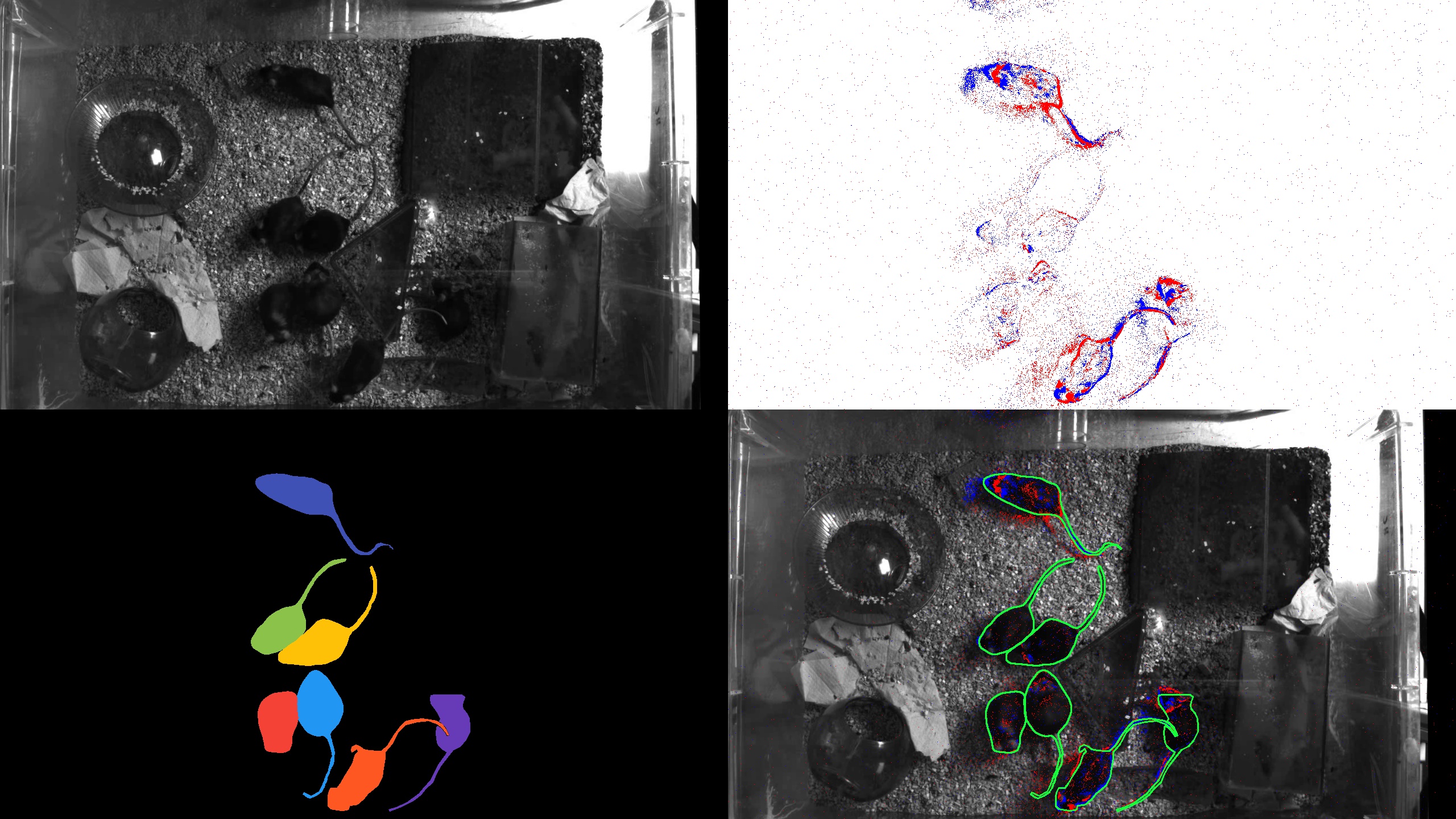This is the official repository for MouseSIS: A Frames-and-Events Dataset for Space-Time Instance Segmentation of Mice, accepted at the Workshop on Neuromorphic Vision in conjunction with ECCV 2024 by Friedhelm Hamann, Hanxiong Li, Paul Mieske, Lars Lewejohann and Guillermo Gallego.
👀 Currently, the test set of this dataset is not available in preparation of a challenge (see split in the paper Tab. 2). You can still run our baseline method on the validation set and we'll soon provide access to an evaluation server. Stay tuned or in case of questions contact us!
- Installation
- Data Preparation
- Evaluation
- Training
- Acknowledgements
- Citation
- Additional Resources
- License
-
Clone the repository:
git clone https://github.com/tub-rip/MouseSIS_dev.git cd MouseSIS_dev -
Set up the environment:
conda create --name MouseSIS python=3.8 conda activate MouseSIS
-
Install PyTorch (choose a command compatible with your CUDA version from the PyTorch website):
conda install pytorch torchvision pytorch-cuda=12.1 -c pytorch -c nvidia
-
Install other dependencies:
pip install -r requirements.txt
-
Create a folder for the original data
cd <project-root> mkdir -p data/orig
-
Download the data and annotation and save it in
<project-root>/data/orig. Thedata/origfolder should be organized as follows:data/orig/ │ ├── top/ │ ├── seq_01.hdf5 │ ├── seq_02.hdf5 │ ├── ... │ └── seq_33.hdf5 │ ├── dataset_info.csv └── annotations.json
top/: This directory contains the frame and event data for the Mouse dataset captured from top view, stored as 33 individual.hdf5files, each containing approximately 20 seconds of data (around 600 frames), along with temporally aligned events.dataset_info.csv: This CSV file contains metadata for each sequence, such as recording dates, providing additional context and details about the dataset.annotations.json: The annotation file of top view follows a structure similar to MSCOCO's format in JSON, with some modifications. The definition of json file is:
{ "info": { "description": "string", "version": "string", "date_created": "string" }, "videos": [ { "id": "string", // video_id from "01" to "33" "width": 1280, // Width of the video in pixels "height": 720, // Height of the video in pixels "length": "int" // Number of frames in the video } ], "annotations": [ { "id": "int", // Instance number for the mouse "video_id": "string", // Corresponding video_id from "01" to "33" "category_id": 1, // The category ID for the object "segmentations": [ { "size": [720, 1280], // Size of the segmentation mask "counts": "RLE encoded string or null" // RLE encoded segmentation or null } ], "areas": [0.0], // Area of the object (can be null) "bboxes": [[0.0, 0.0, 0.0, 0.0]], // Bounding box for the object [x_min, y_min, width, height] "iscrowd": 0 } ], "categories": [ { "id": 1, "name": "mouse", "supercategory": "animal" } ] } -
To evaluate the ModelMixSORT method or train the YOLO model used within it, you first need to convert the original dataset into YOLO format. For grayscale frames, Please run the following command.
python3 scripts/preprocess.py --data_root data/orig --data_format frame
For reconstructed e2vid images, Please run the following command.
python3 scripts/preprocess.py --data_root data/orig --data_format e2vid
You can check the preprocessed data under
data/prepocessed
-
Download the model weights:
mkdir models # Download yolo_e2vid.pt, yolo_frame.pt, and XMem.pth from the provided link # and place them in the models directory
-
Run inference:
python3 scripts/inference.py --config configs/predict/combined.yaml
We provide several config files in
configs/predictfor the different inference settings. The inference script produces per sequence predictions and visualizations. All predictions are summarized infinal_results.json. Each prediction follows this structure:[ { "video_id": int, "category_id": int, "segmentations": [ { "size": [int, int], "counts": "RLE encoded string or null" }, ... ], "score": float }, ... ]The
final_results.jsonfile is also saved under thesrc/TrackEval/data/trackersfolder for use with the TrackEval evaluation tool. -
Evaluate the results (based on TrackEval). The general command is:
python src/TrackEval/run_mouse_eval.py --TRACKERS_TO_EVAL <tracker_name> --SPLIT_TO_EVAL <split_name>
So, if you run inference with
configs/predict/combined.yaml, the command looks like this:python src/TrackEval/run_mouse_eval.py --TRACKERS_TO_EVAL combined_0.1 --SPLIT_TO_EVAL test_wo17
The provided result in the paper is Tab. 4 line 3 (w/o 1 & 7).
To evaluate your own method, please generate the output in JSON format, following the structure of final_result.json as described in the evaluation section. Place this JSON file in src/TrackEval/data/trackers/<your_tracker_name>/test, where your_tracker_name should be replaced with the name of your own tracker. Then, run the evaluation using the command:
python src/TrackEval/run_mouse_eval.py --TRACKERS_TO_EVAL <your_tracker_name> --SPLIT_TO_EVAL <split_name>To train the yolo models used in ModelMixSORT using preprocessed grayscale mice data, please run:
python scripts/train.py --config configs/train/frame.yaml
To train the yolo model using preprocessed e2vid mice data, please run:
python scripts/train.py --config configs/train/e2vid.yaml
We greatfully appreciate the following repositories and thank the authors for their excellent work:
If you find this work useful in your research, please consider citing:
@inproceedings{hamann2024mousesis,
title={MouseSIS: A Frames-and-Events Dataset for Space-Time Instance Segmentation of Mice},
author={Hamann, Friedhelm and Li, Hanxiong and Mieske, Paul and Lewejohann, Lars and Gallego, Guillermo},
booktitle={Proceedings of the European Conference on Computer Vision Workshops (ECCVW)},
year={2024}
}- Recording Software (CoCapture)
- TU Berlin, RIP lab Homepage
- Science Of Intelligence Homepage
- Event Camera Class at TU Berlin
- Event-based Vision Survey Paper
- List of Event Vision Resources
This project is licensed under the MIT License - see the LICENSE file for details.



